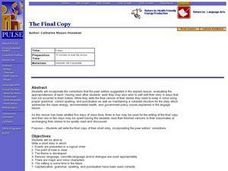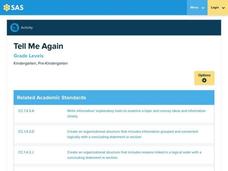Curated OER
Debating Controversial Issues: Integrating Science and Current Events
In order to give young scientists experience with critical thinking skills, introduce them to a current controversy and prepare them to debate. Choose a topic, such as genetically modified organisms, and assign groups to represent...
For the Teachers
Sequence Plot Chart
Your kids can identify the plot sequence of a short story, but what about an informational article? Have them examine the chronological order of events in informational texts with a activity on the sequence of events.
University of Colorado
Astro-Chronology
Class members play a version of the game Chronology to determine when certain scientific events occurred in history. Teams play until someone has 5-10 events in the correct order.
Learn NC
A Christmas Carol Chronology
Which comes first? The Ghost of Christmas Past, Present, or Future? What clues can readers use to establish the chronology of A Christmas Carol? The tale of Ebenezer Scrooge, Marley, and Tiny Tim provides the text for an activity that...
Curated OER
Current Events and Prices
Students read a recent article about the likelihood of a decrease or increase in prices of a specific consumer good. Using the Internet, they examine current events and make predictions about their effect on the economy. They write an...
For the Teachers
Story Strips Sequencing
What happens next? Work on story sequence with a lesson that prompts kids to put a story back in order. Additionally, they discuss what would happen if one event was missing from the sequence.
Southern Nevada Regional Professional Development Program
Common Core Reading Standards: Understanding Argument
What does your class know about logical fallacies? They can find out quite a bit and practice identifying logical fallacies if you follow the steps and use the resources provided here! After reviewing ethos, pathos, and logos, ask small...
Curated OER
The Final Copy
Write short stories in which events are presented in logical order, point of view is clear, theme and characters are developed. Middle schoolers also work on sensory language, concrete language and/or dialogue. They establish their...
Curated OER
Narrative Nuts and Bolts
After viewing slides and reading about child labor, young authors compose an original narrative story. They practice note-taking skills and work to effectively engage a reader by incorporating plot, logical order, complex characters,...
Curated OER
Title of Segment: Balance of Trade
Young scholars take a closer look at the balance of trade. In this current events lesson, students watch PBS video clips about American trade with China. Young scholars research Chinese production and consumerism in order to...
Code.org
Digital Assistant Project
Scholars apply previously learned skills to create a functional computer program. They produce a digital assistant incorporating string commands and complex conditional logic.
Curated OER
Critical Thinking - Week 11
In this critical thinking worksheet, students complete problems which require abstract reasoning and logic. They complete logic puzzles involving sums of an array, finding the maximum number of integers under given conditions, and card...
Curated OER
Organizational Structures of Nonfiction Text/Graphic Organizers
Fifth graders review the characteristics of a nonfiction text. In this language arts lesson, 5th graders understand that one can use a specific graphic organizer to help them in understanding an organizational structure. For example, in...
Code.org
Image Scroller with Key Events
Discover how to embed images in lists. Scholars modify an existing app to include an image scroller in the 17th lesson of the series. They learn to refactor code and remove redundancies after modifying code.
Curated OER
Sunrise Sequencing
Students examine sequencing events by discussing what they do each morning. They complete a four-panel sequence of events assignment, drawing a picture and writing a sentence for each box in the panel.
Pennsylvania Department of Education
Tell Me Again
Students demonstrate how to retell a story in sequential order. In this reading comprehension lesson, students listen to a suggested read aloud, such as Little Boy Blue. Additionally, students practice retelling the story by using...
Curated OER
Using Inspiration To Support Logical Reasoning
Students share descriptions of science experiments they have conducted. They create a thin film on the surface of water in order to float light objects and observe that a paper clip does, indeed, float on the surface of the water at...
Curated OER
Evolution of Our Solar System
Learners research pertinent solar system formation and Earth development events and work together to determine which events occurred first, second, third, and so on. Students arrange themselves as a human timeline across the room. ...
Chicago Botanic Garden
Climate Change Around the World
It is unknown if cloud cover increases in response to carbon dioxide levels changing, helping climate change slow down, or if cloud cover decreases, allowing Earth to warm faster. Part four in the series of five lessons has classes...
Pennsylvania Department of Education
6 Traits: Organization
Students make logical patterns in their writing to demonstrate the trait of organization. In this organization lesson plan, students focus on events proceeding logically.
Curated OER
Dragonwings: Explore Chapters 1-5
If you are beginning Laurence Yep's Dragonwings, this will provide activities for the first five chapters. The objectives include making connections to oneself and the world, organizing information and events, vocabulary acquisition,...
Curated OER
The Very Hungry Caterpillar
Here is a good activity on butterflies and caterpillars. After listening to The Very Hungry Caterpillar, young learners put cards that depict the life cycle of a butterfly in the correct order. There are some good ideas for center...
Curated OER
What Plants Need in Order to Survive and Grow: Soil
Young scholars conduct an experiment to evaluate whether plants need soil to survive and grow. They plant two seeds, one with soil and one without, make predictions, and record and analyze the seed germination results on a worksheet.
Think Like A Programmer! Puzzlets Cork the Volcano Curriculum
Common Core Standards Connected
The standards listed below are standards from the Common Core Framework which map to learning opportunities with Cork The Volcano & Puzzlets.
Source Link:...























